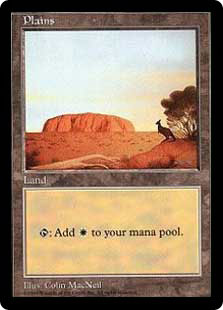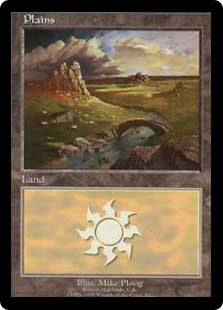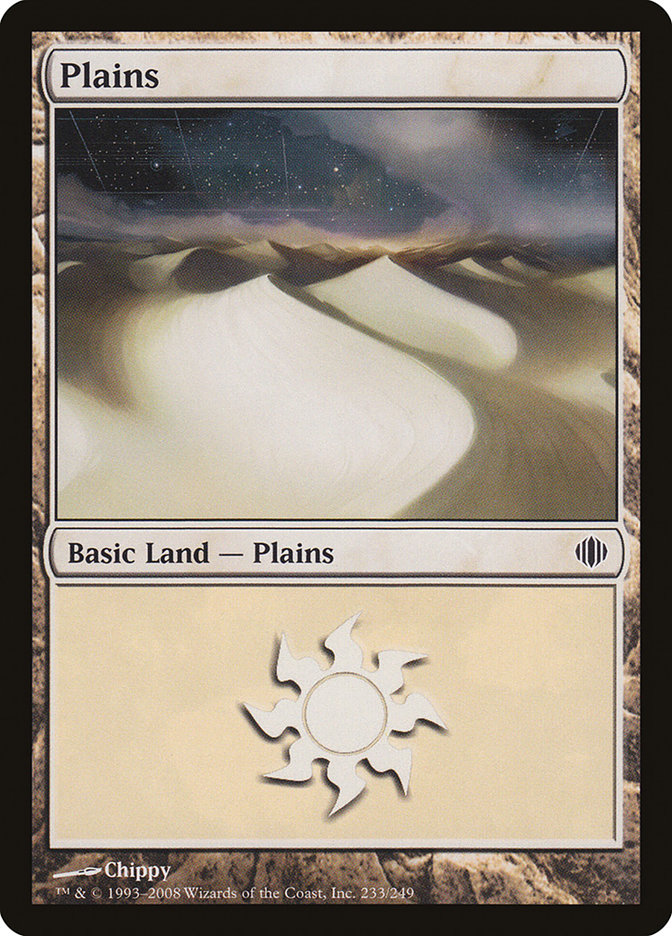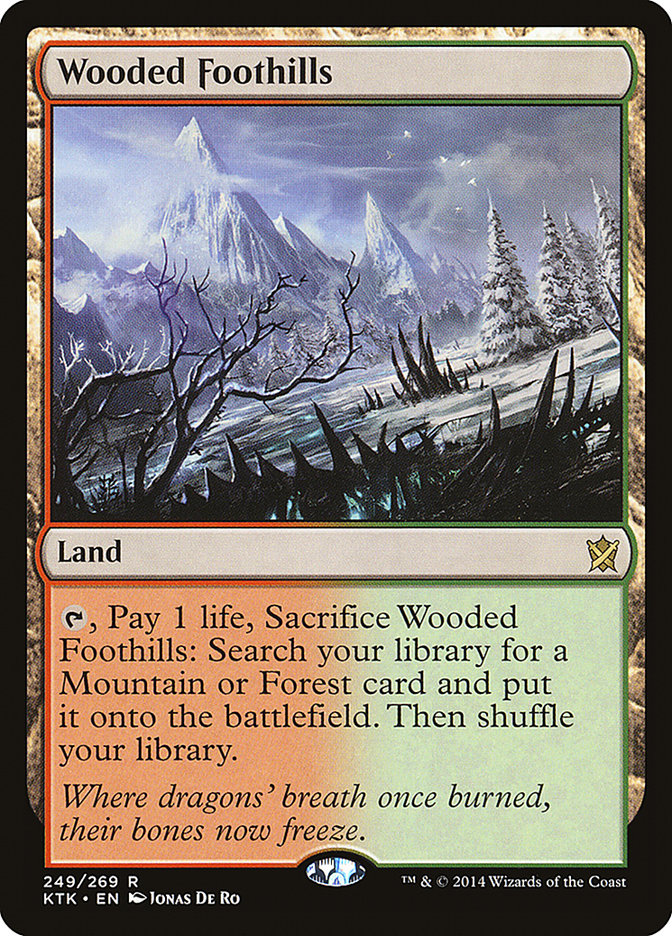Some of my favorite basic land sets are the APAC and Euro lands. Released in 1998 (APAC) and 2000/2008 (Euro) to Magic players of those
regions, the APAC and Euro lands brought real-world flavor — and a certain rarity — to the world of basic land connoisseurs. It’s one thing to use a
Plains from Kamigawa or Shadowmoor or some other place that none of us will ever be able to visit in person. It’s quite another to tap Uluru, the Great Wall of China, or the Scottish Highlands for one’s white mana!
If anyone has travel tips for visiting the Scottish Highlands, please let me know in the comments!
Nowadays, with Wizards of the Coast putting a decided emphasis on cutting off any real-world connections to Magic cards, nothing like the APAC or Euro
lands would get authorized today. To me that’s a shame, because there are plenty of awesome places left on Earth that would look amazing as rendered on
Magic cards … particularly North America!
So consider this article a showcase of what we’re all missing — the three “packs,” akin to the blue, red, and purple boosters of Euro Lands, that might
have been for Magic: The Gathering basic lands depicting the beautiful sights of the USA and Canada.
Plains
USA #1:
Homestead National Monument, Nebraska.
The first Homestead Act of 1862 was a key piece of legislation in U.S. history that literally
gave away unclaimed land in the Midwest and elsewhere in exchange for five years of hard labor living on and cultivating that land. Though often abused,
the Homestead Act forever reshaped the country. The Homestead National Monument near Beatrice, Nebraska is the site of one of the first claimed homesteads
and includes an area restored to resemble the famous pre-homesteading Midwestern prairie.
For those of a certain age who did Academic Decathlon in high school,
Homestead is also the site of the Palmer-Epard Cabin,
which I studied for myself on a trip taken with my mother. Oddly enough, I remember Homestead less than the Friday Night Magic I played at a store in
Beatrice, where I was the lucky eighth player they needed for their Onslaught – Legions – Scourge booster draft. The draft didn’t go so well for
me, but I had a great time!
USA #2:
Great Sand Dunes National Park and Preserve, Colorado.
This surreal landscape of dunes was created over millennia as desert sand picked up by great winds came to rest at the foot of a mountain range. Have you
ever seen the Plains from Shards of Alara with the great glass dunes of Esper? I’ve been to a similar place, in day instead of night, and it’s
more beautiful than even the greatest painter could imagine.
Canada:
Head-Smashed-In Buffalo Jump, Alberta.
This traditional site of the Blackfoot First Nation was used for millennia as the end point of bison hunts. Hunters would drive bison toward and over a
cliff, while others would lie in wait at the bottom to finish the kill. While a number of “buffalo jumps” are known in both the USA and Canada, I’ve chosen Head-Smashed-In for its fame as a UNESCO World Heritage Site.
Islands
USA #1:
Mackinac Island, Michigan.
Please don’t call it “Mack-i-nack.” It’s “Mack-i-naw,” and it’s the site of the second National Park ever protected in the USA (though it’s a state park and
National Historic Landmark these days). Once a key fur trading area that saw two battles fought during the War of 1812, Mackinac Island later became a summer hangout of the rich and famous with virtually
all automotives banned (most travel on the island is by horse-drawn carriage instead, even today). I’ve eaten way too much Mackinac Island fudge for my waistline’s
good.
USA #2:
Papahanaumokuakea Marine National Monument,
Hawaii and U.S. Minor Outlying Islands.
This marine habitat named after a Native Hawaiian creator goddess and her consort stretches
to the northwest from the “core eight” Hawaiian islands to the famous World War
II battlefield of Midway and beyond. The monument is home to thousands of species, hundreds of
them found nowhere else on Earth; Midway Atoll is famous for its albatross colony as well as
its military history.
Canada:
Prince Edward Island, Prince Edward Island.
The smallest Canadian province, Prince Edward Island packs plenty of history into its compact form, including the start of a unified Canada itself at an 1864 conference held in the capital, Charlottetown. The maritime province, still
largely rural, is famous in the USA as the setting for Anne of Green Gables and
the subsequent book series.
Swamps
USA #1:
The Everglades, Florida.
Obvious? Sure, but they’re also among the most famous swamplike environments in the world — and also the most endangered; Everglades National Park covers only a fraction of what once existed. As for a Magic
connection, I’ll just leave this card here…
USA #2:
Bayou Bartholomew, Arkansas and Louisiana.
The French-meets-English term “bayou” lent itself to one of the original ten dual lands of Magic, and Bayou Bartholomew is the
longest of them all, stretching across Louisiana and into Arkansas to the north. Historically an important waterway, today it’s a popular fishing location.
Other bayous, a few perhaps more picturesque, can be found throughout Louisiana and the rest of the Gulf Coast.
Canada:
Minesing Wetlands, Ontario.
Located in the southern part of Ontario, the Minesing Wetlands is one of the most complex ecosystems in the province and home to an abundance of wildlife.
Depending on the season, visitors from Ontario and beyond may be found either canoeing down the waterways or snowshoeing across the land.
Mountains
USA #1:
Denali, Alaska.
The tallest peak in North America, Denali in the interior of Alaska is one of the famous “Seven Summits” tackled by mountaineers from around the globe. Denali is part of the prominent Alaska Range found just beyond the more easily accessible southern coast of the state and among
the northernmost peaks in the “Ring of Fire” surrounding the Pacific Ocean.
USA #2:
Mill Mountain, Virginia.
Contained within the borders of the city of Roanoke, Mill Mountain is part of the Blue Ridge Mountains in the Appalachian range. Mill Mountain is most famous for the giant neon-lit star feature
placed on the summit in the 1940s, which led to Roanoke’s nickname as the “Star City.” Many local businesses have taken up the nickname “Star City” for
themselves, including Star City Games.
Canada:
Barbeau Peak, Nunavut.
There’s north, and then there’s north. Barbeau Peak is high up in the Canadian Arctic at over 80 degrees north latitude — that’s less than ten
degrees out of ninety short of the North Pole — within the Inuit-dominated territory of Nunavut.
Remote and majestic with a few spines of gray rock outlining broad expanses of white ice and snow, Barbeau Peak would make a marvelous Mountain,
particularly if paired with a clear blue sky.
Forests
USA #1:
Sequoia National Park
/
Giant Sequoia National Monument, California.
While plenty of Magic’s Forests have tried to get the idea of a big tree across, few of them can stand up to the real-life giant sequoias of California. Try wrapping your head around the biggest of them all,
the “General Sherman” — 275 feet tall, 25 feet around (that’s over 80 meters and
almost 8 meters, respectively, for those of you on the metric system), and 130 feet (40 meters) straight up before the first branch? Everyone I know who’s
been there has told me that pictures alone don’t do the sight of a giant sequoia justice. Even so, I’d like to see a Magic illustrator try!
USA #2:
Green Mountain National Forest, Vermont.
Yes, yes, it has “Mountain” right in its title. It’s the USA and a lot of the remaining forests are in mountainous areas, so deal with it! Anyway, Green
Mountain National Forest is close to the US/Canadian border in the New England-Acadia region. My memories of my pass through Green Mountain have
dimmed — I was only ten years old at the time, and my family was hurrying home from Canada — but a great real-life forest still leaves me in awe.
Canada:
Kluane National Park and Reserve, Yukon.
Tucked into the southwestern corner of Yukon (formerly the Yukon Territory) next to the British Columbia and Alaska borders, Kluane is an important and
varied landscape that includes the tallest mountain in Canada, Mount Logan. While much of the park is defined by mountains and glaciers, in the east there
are small but beautiful wooded on the edge of the climate where “forests” themselves are possible, a testament to the tenacity of life.
**
So that’s one possible look at what might have been for North America basic land packs. I know I probably left out your favorite state and features (Manhattan! Key West! Texas Panhandle!), so now it’s your turn. What features of the US and Canada would you have
liked to see on North America basic lands?







